Bandoneon
The bandoneon (or bandonion, Spanish: bandoneón) is a type of concertina particularly popular in Argentina and Uruguay. It is an essential instrument in most tango ensembles from the traditional orquesta típica of the 1910s onwards. As with other members of the concertina family, the bandoneon is held between both hands, and by pulling and pushing actions force air through bellows and then routing air through particular reeds as by pressing the instrument's buttons. Bandoneons have a different sound from accordions, because bandoneons do not usually have the register switches that are common on accordions. Nevertheless, the tone of the bandoneon can be changed a great deal using varied bellows pressure and overblowing, thus creating potential for expressive playing and diverse timbres.
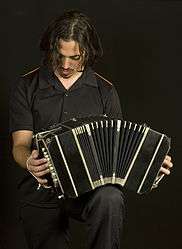 | |
| Keyboard instrument | |
|---|---|
| Classification |
Aerophone Free reed Wind |
| Hornbostel–Sachs classification | 412.132 (Free-reed aerophone) |
| Developed | Germany mid-1800s |
| Related instruments | |
| Chemnitzer concertina, concertina, harmonica, melodeon, reed organ, yu | |
| Musicians | |
| Ástor Piazzolla, Aníbal Troilo | |
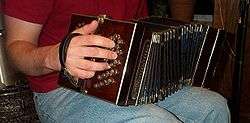

History
The Bandonion, so named by the German instrument dealer Heinrich Band (1821–1860), was originally intended as an instrument for religious and popular music of the day, in contrast to its predecessor, German concertina (Konzertina), which had predominantly been used in folk music.[1]:16 Around 1870, German and Italian emigrants and sailors brought the instrument to Argentina, where it was adopted into the nascent genre of tango music, a descendant of the earlier milonga.[2]
By 1910 bandoneons were being produced expressly for the Argentine and Uruguayan markets, with 25,000 shipping to Argentina in 1930 alone. However, declining popularity and the disruption of German manufacturing in World War II led to an end of bandoneon mass-production.[1]:17
Original instruments can be seen in a number of German museums, such as the Preuss family's Bandoneon Museum in Lichtenberg and the Steinhart family's collection in Kirchzarten, Freiburg.
Historically, bandoneons were produced primarily in Germany and never in Argentina itself, despite their popularity in that country. As a result, vintage bandoneons had by the 2000s become rare and expensive (costing around 4000 USD), limiting the opportunities for prospective bandeonists. In 2014, the National University of Lanús announced its plan to develop an affordable Argentine-made bandoneon, which it hoped to market for one-third to one-half of the cost of vintage instruments.[3]
Technique
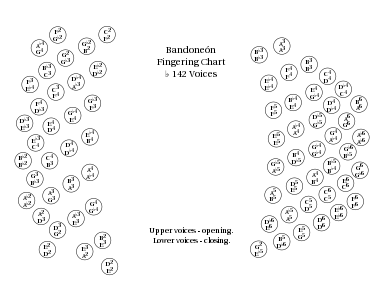
As with other members of the concertina family, the bandoneon is held between both hands, and pulling and pushing actions force air through bellows and then through particular reeds as selected by pressing the instrument's buttons. As with other concertinas, the button action is in parallel to the motion of the bellows, and not perpendicular to it as with an accordion.
Unlike what happens with a piano accordion, but in similar fashion to a melodeon or Anglo concertina, a given bandoneon button produces different notes on the push and the pull (bisonoric). This means that each keyboard actually has two layouts: one for opening notes, and one for closing notes. Since the right and left hand layouts are also different, a musician must learn four different keyboard layouts to play the instrument.[1]:18
These keyboard layouts are not structured to make it easy to play scale passages of single notes: they were originally laid out to facilitate playing chords, for supporting singers of religious music in small churches with no organ or harmonium, or for clergy requiring a portable instrument (missionaries, traveling evangelists, army and navy chaplains, and so forth).
Players
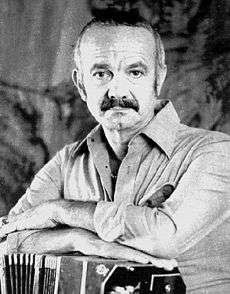
The Argentinian bandleader, composer, arranger, and tango performer Aníbal Troilo was a leading 20th-century proponent of the bandoneon. The bandoneon player and composer Ástor Piazzolla played and arranged in Troilo's orquesta from 1939 to 1944. Piazzolla's "Fugata" from 1969 showcases the instrument, which plays the initial fugue subject on the 1st statement, then moves on to the outright tango after the introduction. With his solos and accompaniment on the bandoneon, Piazzolla combined a musical composition much derived from classical music (which he had studied intensively in his formative years) with traditional instrumental tango, to form nuevo tango, his new interpretation of the genre.
List of luthiers and manufacturers
A list of some current bandoneon manufacturers:
- Asociación Argentina de Luthiers
- Baldoni Accordions (USA)
- Bandoneón AZ - Ángel y Gabriel Zullo (Argentina)
- Bandoneones A. A. Alfred Arnold (Germany)
- Bandoneones F. F. - Juan Pablo Fredes (Gambier, La Plata, Argentina)
- Bandoneones Baltazar Estol (Argentina)
- Bandoneones Toscano (Mendoza, Argentina), Vicente Toscano, fabricante y restaurador de bandoneones.
- Bandonion & Concertinafabrik Klingenthal (Germany)
- Mario Bianco (Uruguay)
- Castagnari (Italy)
- Danielson Industria de Acordeões e Bandoneões (Brazil)
- D. & J. Trupin SARL (France)
- Enrique Fasuolo (Argentina)
- Oscar Fisher (Argentina)
- Giustozzi (Italy)
- Klaus Gutjahr (Germany)
- Harry Geuns Bandoneons (Belgium)
- Uwe Hartenhauer (Germany)
- Ricardo Matteo (Uruguay)
- Museo Luis Alfredo Mariani (La Reja, Moreno, Argentina)
- Pigini Fratelli & C. snc (Italy)
- Premier Bandoneonbau Peter Spende (Germany)
- Stagi Accordions & Bandoneons (Italy)
- Tangobrujo Venta & Restauraciones - Daniel Barrientos (Argentina)
- Victoria Accordions Company (Italy)
Prominent players
- Juan Félix “Pacho”Maglio (1881-1934)
- Arturo Bernstein (1882-1935)
- Juan de Dios Filiberto (1885-1964)
- Genaro Espósito (1886-1944)
- Vicente Greco (1888-1924)
- Augusto Berto (1889-1953)
- Abel Bedrune (1889-1967)
- Bachicha (1890-1963)
- Eduardo Arolas (1892-1924)
- Ricardo Brignolo (1892-1954)
- Juan Canaro (1892-1977)
- Salvador Grupiglio (1893-1956)
- Luis D'Abbraccio (1894-1948)
- Pedro Polito (1894-1958)
- José Schumacher (1894-1958)
- Víctor Lomuto (1895-1959)
- Ricardo González (1885-1962)
- Manuel Pizarro (1895-1982)
- Antonio Bonavena (1896-1960)
- Anselmo Aieta (1896-1964)
- Roque Biafore (1896-1975)
- Osvaldo Fresedo (1897-1984)
- Minotto Di Cicco (1898 -1979)
- Ángel Danesi (1898-1980)
- Pedro Maffia (1899–1967)
- Francisca "Paquita" Bernardo (1900-1925)
- Pedro Laurenz (1902–1972)
- Luis Petrucelli (1903-1941)
- Carlos Marcucci (1903-1957)
- Mario Canaro (1903-1974)
- Alberto Celenza (1903-1981)
- Héctor Artola (1903-1982)
- Ciriaco Ortiz (1905-1970)
- Mario Melfi (1905-1970)
- Ricardo Malerba (1905-1974)
- Ángel Ramos (1905-1979)
- Domingo Cuestas (1907-1968)
- Miguel Caló (1907-1972)
- José Dames (1907-1994)
- Miguel Bonano (1907-2001)
- Armando Blasco (1908-1991)
- Félix Verdi (1909-2003)
- Alberto Cima (1910-1980)
- Lucas Demare (1910-1981)
- Juan Caló (1910-1984)
- Alfredo Calabró (1911-1977)
- Gabriel Clausi (1911-2010)
- Federico Scorticati (1912-1998)
- Eladio Blanco (1913-1993)
- Aníbal Troilo (1914–1975)
- Alfredo Attadía (1914-1982)
- Hector Varela (1914-1987)
- Alberto Mancione (1915-1998)
- Jorge Argentino Fernández (1915-2002)
- Jorge Sara (1917-1966)
- Eduardo Marino (1916-1980)
- Julio Ahumada (1916-1984)
- Juan Cambareri (1916-1992)
- Domingo Federico (1916-2000)
- Marcos Madrigal (1916-2010)
- Alfredo Cordisco (1916-2016)
- Armando Pontier (1917-1983)
- Antonio Ríos (1917-1991)
- Tránsito Cocomarola (1918-1974)
- Alberto Caracciolo (1918-1994)
- Donato Racciatti (1918-2000)
- Enrique Alessio (1918-2000)
- Ismael Spitalnik (1919-1999)
- Juan Miguel Rodríguez (1919-2004)
- Edelmiro D'Amario (1920-2001)
- Astor Piazzolla (1921–1992)
- Osvaldo Ruggiero (1922-1994)
- José Appendino (1922-2010)
- Juan Carlos Caviello (1923-2016)
- Jorge Caldara (1924-1967)
- Atilio Corral (1924-1982)
- Roberto Di Filippo (1924-1991)
- Eduardo Rovira (1925-1980)
- Carlos Lazzari (1925-2009)
- Arturo Penón (1927-2000)
- Leopoldo Federico (1927-2014)
- Julián Plaza (1928-2003)
- Alfredo Marcucci (1929-2010)
- Carmelo Gentiluomo (1930-1997)
- Eduardo Cortti (1930-2000)
- Luis Stazo (1930-2016)
- Roberto Pansera (1932-2005)
- Ernesto Baffa (1932-2016)
- José Libertella (1933-2004)
- Daniel Lomuto (1934-1994)
- Raúl Garello (1936-2016)
- Osvaldo Rizzo (1938-2004)
- Carlos Galván (1940-2014)
- Domingo Moles (1944-1992)
- Rubén Juárez (1947-2010)
- Claudio Constantini
- Héctor del Curto
- Richard Galliano
- Juan Pablo Jofre
- Rubén Juárez
- Per Arne Glorvigen
- Jonathan Goldman
- Gianni Iorio
- Ryōta Komatsu
- Carel Kraayenhof
- Rodolfo Mederos
- Gabriel Merlino
- Alexander Mitenev
- Juan José Mosalini
- Gordon Mumma
- Pauline Oliveros
- Hermeto Pascoal
- Kimmo Pohjonen
- Michel Portal
- Gabriel Rivano
- Dino Saluzzi
- John Spiers
- Mika Väyrynen
Construction
Exterior:
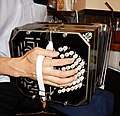 Alfred Arnold bandoneon. Right
Alfred Arnold bandoneon. Right
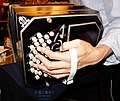 Left. Note that each button has its number or symbol
Left. Note that each button has its number or symbol
A look inside a bandoneon:
References
- Alejandro Marcelo Drago (2008). Instrumental Tango Idioms in the Symphonic Works and Orchestral Arrangements of Astor Piazzolla. Performance and Notational Problems: A Conductor's Perspective. ProQuest. ISBN 978-0-549-78323-7.
- Carlos G. Groppa (30 December 2003). The Tango in the United States: A History. McFarland. pp. 69–. ISBN 978-0-7864-2686-7.
- Jemio, Diego (6 November 2014). "The musical key to keeping Argentina dancing the tango". BBC News. Retrieved 13 November 2014.
- Rubén Pérez Bugallo (1 January 1993). Catálogo ilustrado de instrumentos musicales argentinos. Ediciones Del Sol. pp. 77–. ISBN 978-950-9413-49-8.
External links
| Wikimedia Commons has media related to Bandoneón. |
- Proyecto Bandomecum Bandoneon's Portal Page
- Christian's Bandoneon Page




